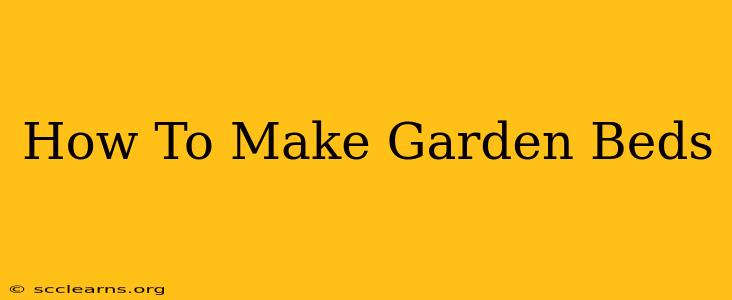Creating your own garden beds is a rewarding experience, allowing you to cultivate your favorite plants and enjoy the beauty of homegrown produce. Whether you're a seasoned gardener or a complete novice, this guide will walk you through the process of building beautiful and functional garden beds. We’ll cover everything from choosing the right location to selecting the best materials and maintaining your new garden beds for years to come.
Choosing the Perfect Location for Your Garden Beds
Before you even think about digging, selecting the ideal spot for your garden beds is crucial. Consider these factors:
- Sunlight: Most vegetables and flowers need at least 6-8 hours of direct sunlight per day. Observe your yard throughout the day to identify areas that receive ample sunshine.
- Water access: Easy access to a water source is essential, especially during dry spells. Locate your beds near a hose or consider installing a drip irrigation system.
- Soil drainage: Poor drainage can lead to root rot and plant death. Avoid areas prone to waterlogging. Test your soil’s drainage by digging a hole and filling it with water. If it drains slowly, consider amending the soil or choosing a different location.
- Accessibility: Make sure your garden beds are easily accessible for planting, weeding, and harvesting. Avoid placing them in areas that are difficult to reach or that might obstruct foot traffic.
Types of Garden Beds and Materials
There's a wide variety of garden bed designs to choose from, each with its own advantages and disadvantages. Here are a few popular options:
1. Raised Garden Beds
Advantages: Excellent drainage, warmer soil temperatures, ideal for areas with poor soil quality, easier to manage weeds.
Materials: Common materials include treated lumber, untreated cedar, redwood, stone, and even recycled materials like pallets (ensure they are treated appropriately).
2. In-Ground Garden Beds
Advantages: Less expensive than raised beds, integrates well with the existing landscape.
Disadvantages: Can be more challenging to manage weeds, drainage can be an issue depending on soil type.
3. Container Gardening (as a type of garden bed)
Advantages: Highly portable, ideal for small spaces, excellent drainage control.
Disadvantages: Requires more frequent watering, limited root space.
Building Your Garden Bed: A Step-by-Step Guide
Let's focus on building a simple raised garden bed as an example. The process is similar for other types, but with necessary material adjustments.
1. Prepare the Area: Clear the chosen area of grass, weeds, and any debris.
2. Mark the Dimensions: Use stakes and string to mark the desired dimensions of your garden bed.
3. Assemble the Frame: If using wood, assemble the frame using screws or nails. Ensure it's sturdy and level.
4. Line the Bed (Optional): Using landscape fabric or weed barrier can help prevent weeds from growing into your bed.
5. Fill with Soil: Fill the bed with high-quality garden soil, compost, and other soil amendments as needed.
6. Level the Soil: Ensure the soil is level and firm before planting.
Maintaining Your Garden Beds
Once your garden beds are established, proper maintenance is crucial for healthy plant growth. This includes:
- Regular Watering: Water deeply and consistently, especially during dry periods.
- Weeding: Remove weeds regularly to prevent competition for nutrients and water.
- Fertilizing: Amend the soil with compost and fertilizer as needed to replenish nutrients.
- Mulching: Apply a layer of mulch to retain moisture, suppress weeds, and regulate soil temperature.
Conclusion
Creating your own garden beds is a fantastic way to connect with nature and enjoy the fruits (and vegetables!) of your labor. By following these steps and choosing the right materials for your needs and style, you can create a beautiful and productive garden space that will bring you joy for years to come. Remember to adjust the process based on your chosen garden bed style. Happy gardening!

